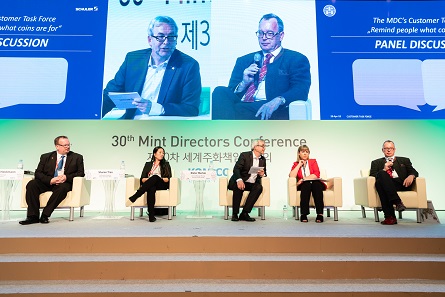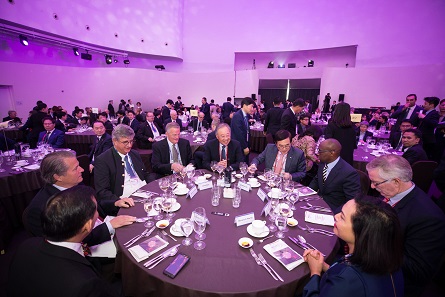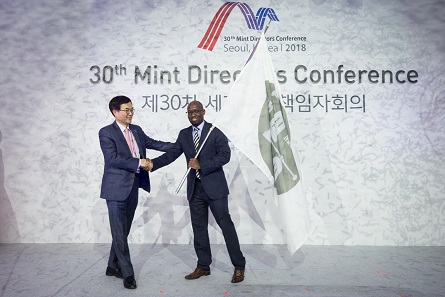by Ursula Kampmann
translated by Almuth Klingner
July 5, 2018 – While, in Panmunjom, Kim Jong-un and Moon Jea-in started a new chapter in the history of Korea, around 250 participants met in Seoul for the 30th Mint Directors Conference between April 22 and 26, 2018. Members of the mint industry from 36 nations were present, coming from central banks and mints, from suppliers, direct marketing companies, the media and coin conventions.
Panel discussing the outcome of the research of the Consumer Task Force: From l. to r. Marius Haldimann (Swissming), Sharon Tran (Royal Australian Mint), Dieter Merkle (Schuler), Astrid Mitchell (Currency News) and Niels Hagemann (MDM). Photo: MDC 2018.
Are we asking the right questions?
What are our customers expecting from their coin? Are they satisfied with the product? Or are there unmet expectations? Who are our customers, anyway? These are only some of the questions currently posed by the Consumer Task Force led by Dieter Merkle.
Task Force – the sub-committee’s name alone implies fast, interdisciplinary action, and in fact, the Consumer Task Force has done and achieved a lot during the few months since its founding. It was created in May 2015 and started its activity on the occasion of the MDC 2016 in Bangkok. In 2017, three meetings of the Task Force as well as two consumer surveys took place. Another survey has been done in Germany, Austria and Switzerland.
No interest in security features
So, what are the results? There are plenty of them, and they provide ample food for thought. In short, the coin industry must face the fact that it has spent years investing and researching in a field that is hardly present in the consumers’ perception. Nobody cares about security features! Coin dealers and central bank representatives simply presume that the security of their coins is guaranteed.
The same goes for private consumers, 49% of which feel safe when using coins. Only 6% regularly check security features! 69% of the users never do!
In the public’s perception, all the elaborate details that make coins more secure play no significant role, unless the media report on some scandal. Quite a sobering realization, when you think about all the technical expertise and high investments that have been spent on their elaboration.
Cash remains king
On the other hand, the survey among coin users confirms the central banks’ perception: Coins are a major part of currency circulation. 9 out of 10 individuals indicated to have used coins during the last two days. 71% consider it important to keep coins. This positive attitude depends a little on age (67% among young people, 81% among older people) and a lot more on income (60% among high-income persons, 83% among low-income persons).
Once again: 83% of the respondents with an income below 1,500 euros think it’s important to have coins! This is an unbeatable argument for everyone lobbying for cash! This result makes coins an existential social factor of our monetary system. Our society’s weakest members, of all people, need coins. In a social market economy which the Western democracies claim for themselves, this should count for more than the potential possibility to use cash for a shadow economy and crimes.
Informal discussions during a dinner are an essential component of the MDC. Photo: MDC 2018.
Beauty lies in the eye of the beholder
The questions posed to the coin users included one about the attractiveness of our circulation coins. There is considerable backlog on this point. Only 19% of the respondents in Germany, Austria and Switzerland consider our coins very attractive. 34% find them rather unattractive.
What’s interesting: The Swiss scored slightly higher here than the Germans and the Austrians. And that despite the fact that the Swiss effigies are the oldest in the world still being minted. Thus, attractiveness is certainly not about modern design, but about the degree of identification with one’s currency. And in that respect, the euro does have slight deficits compared to a venerable currency like the Swiss franc, which probably cannot be compensated even by the best visuals.
Focus on collectability
For those who sell coins to collectors, there is one clear priority: There must be a collector’s demand for the coins, and a decent profit for the seller. Everything else is secondary, which is hardly surprising for anyone who has ever worked in the coin trade.
Sellers look for items that exhibit collectability: a combination of attractiveness, new technology, great design, a good story and – of course – the fact that a coin can in theory be used as payment, even if it has never seen the country of which it bears the name.
And when it comes to collectability, coin dealers are specialists.
In 2020 the next MDC will take place. It will be hosted by South Africa. South Korea passes the flag to South Africa. Photo: MDC 2018.
For the public and the public purse
The central banks, too, have an eye on their income, but not in the sense of profit optimization. A decent profit from minting is nice to have, but as long as the figures remain in the black, representative of central banks and governments prefer not to think about coins at all. They only do when the public demonstrates by its behavior that some denominations are not in line with their demands (cf. the world-wide problems of smaller denominations), or when negative articles about coins are published on social media or in the daily press (cf. Mint News Quarterly 17/2: Mint of Finland withdrew Commemorative Coin Series by Order of Minister of Finance).
The example of Finland shows how much government representatives fear scandals or even just negative feelings, and how drastically they react to them.
The Consumer Task Force’s surveys continue. If you would like to join the committee or take part in the national and international studies, please contact Dieter Merkle.
Part 1 of our articles on the MDC covers the future of cash.
Part 2 is about the different guidelines given out by the MDC.
Part 3 is dedicated to the latest research of the subcommittees.
Here, you get to the website of the MDC 2018.
The Mint Directors Conference has a new website.
The MDC2018 was organized by KOMSCO, die Korea Minting, Security Printing & ID Card Operating Corporation.
On this website, you can find out more about KOMSCO.







